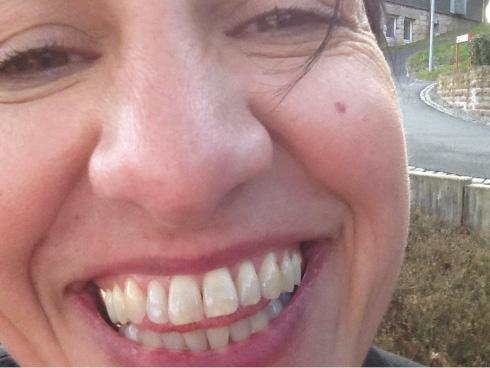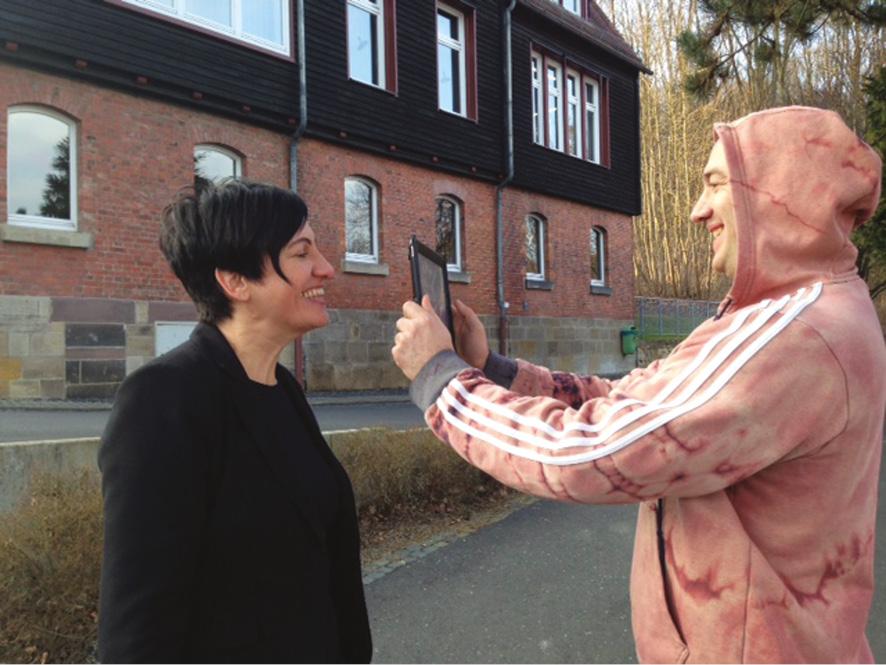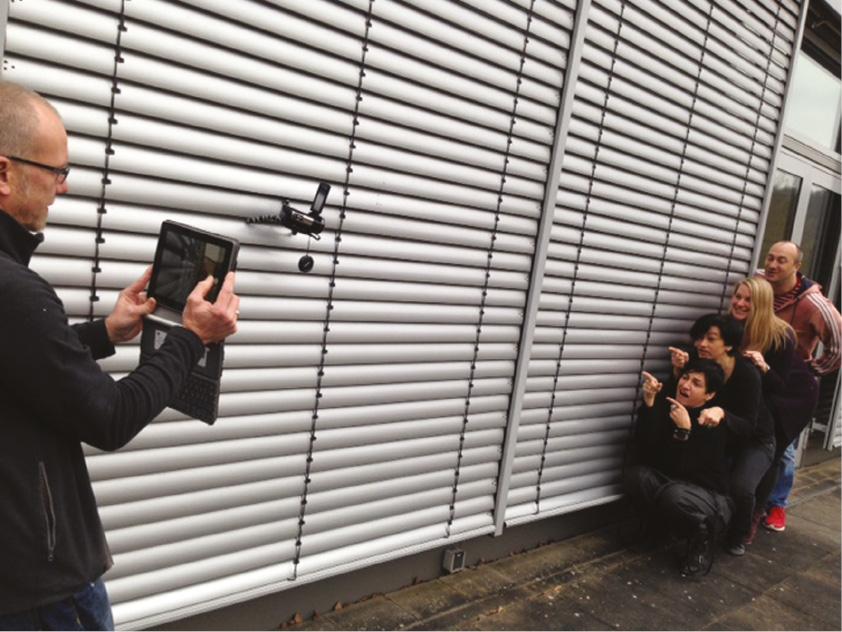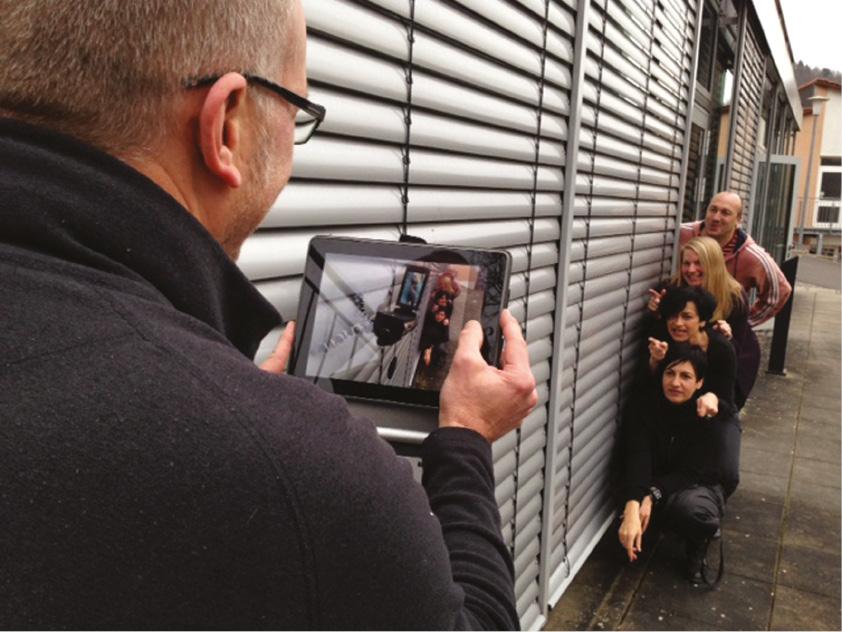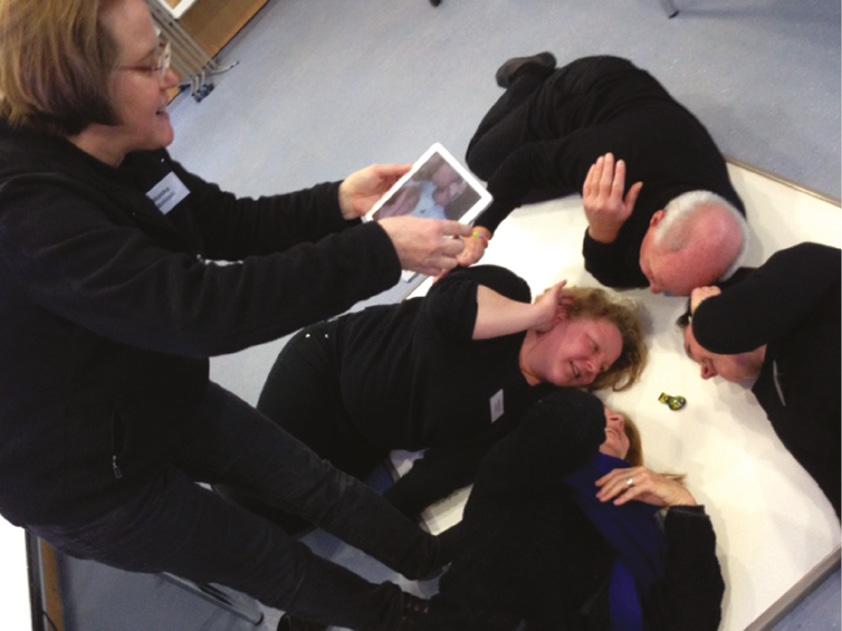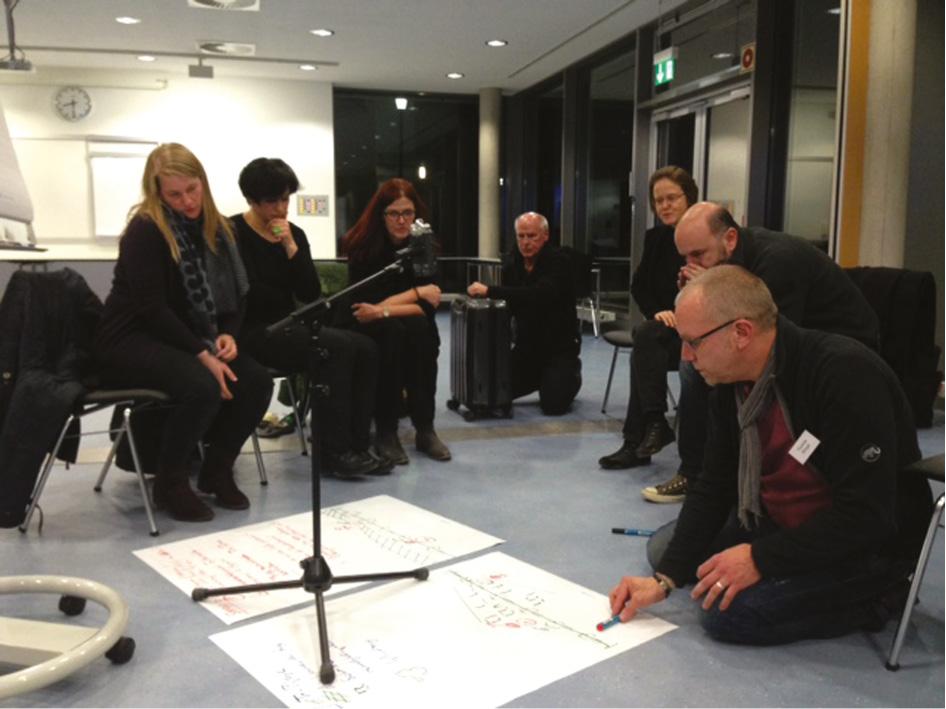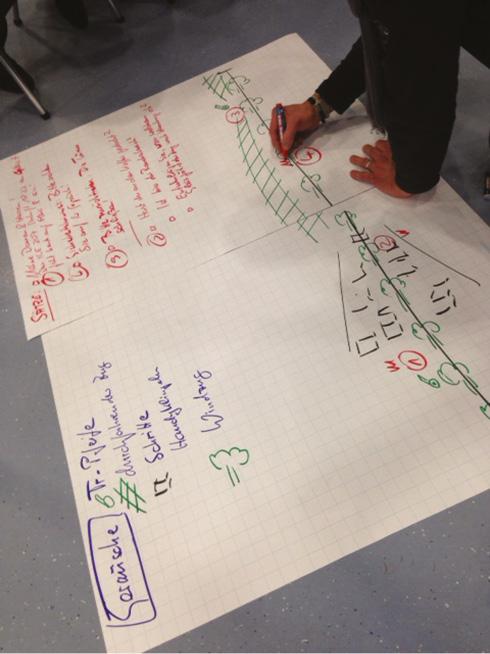Introduction
It is widely accepted that in 2021 most Europeans live in a society wherein ubiquitous accessible and portable media-capturing devices have become a core part of everyday life. This subsequently raises questions for many teaching environments. Practical media production has gradually become incorporated into several areas of both primary and secondary school curricula since the 1990s (Buckingham et al., 1995; Bazalgette, 1989), and has since undergone various forms of development (Potter and Bryer, 2016). Even with technological changes, practical film-making activities for young people remain a focal point in, and outside, school activities. From 2000 onwards, accessible texts to foster these activities have been published by a number of focal non-academic institutions concerned with film, media and education, such as the British and Swedish Film Institutes, Vision Kino and the Medienzentrum network in Germany, Media Animation in Belgium, and the ‘Melina’ Project Education and Culture in Greece (Médiacteurs, 1993; Swedish Film Institute, 2002; BFI, 2002; BFI and DfES, 2003; Theodoridis, 2012).
Applied media projects have been introduced at both a local and a European level, and they are gradually becoming more available to educators both in and outside schools. ICT and digital tools are generally accessible in most European countries, and the number of media-related training resources and projects that continue to be welcomed in the wider education community with European funding support throughout the 2010s is indicative of an ongoing enthusiasm for using film and media for learning. My own informal research indicates that more than 1 in 10 of 10,015 Erasmus+ Key Action: Cooperation for Innovation projects during the years 2014–18 refer to the terms ‘film’, ‘movie’, ‘animation’ or ‘media education’. Considering that Erasmus+ programmes address all kinds of educational methodologies and experimentation (while having a variety of target audiences, such as students in formal education, as well as vulnerable groups and minorities), this would seem to indicate a considerable desire from applicant bodies (usually schools or non-governmental organisations focused upon education) for image-based media, whether as a tool or as a platform, for interdisciplinary work. Such evidence would also seem to indicate that such a tendency continues to receive support from EU representatives.
This short discussion of the recent history of practical media literacy education serves to illustrate that teachers continue to seek knowledge and skills within the broader media sphere. A deeper study of EU Key Actions since 2000, when digital media started making video-making more accessible, would perhaps reveal the inherent contradiction, however, between the large number of teachers keen to extend their media and film practice, and the very limited evidence of inclusion of film-making or media literacy projects in formal curricula (Reid et al., 2013).
This article will look in particular at the engagement of teachers with aspects of film and media language as part of theatre pedagogy practice. While the question of combining the two arts has been addressed before, most studies have tended to deal with projects conducted directly with students through either a media or theatre expert’s intervention or supervision (or, indeed, that of a researcher). This study thus deals with building upon the existing skills of teachers, and enhancing their capacities to engage with the two modes.
Film and theatre in and outside school
Before engaging with the detailed case study at the heart of this article, it is important to provide examples where the respective mediums of film and theatre have previously been combined, either for learning these art forms on their own terms, or as a vehicle to support another field of knowledge or art. Alongside such considerations, I also explore the recurrent theme of teachers’ hesitations in adopting these practices.
The question of the multifaceted connections between theatre and media in education is not new. Certain hypotheses about the methods of learning common to both were established from the 1990s (Buckingham et al., 1995: 172). In 2002, the Swedish Film Institute published a short, manifesto-like publication (Swedish Film Institute, 2002) relating directly to the revised syllabuses for a compulsory school system (which had been in effect since July 2000) in which expression through a wide range of art practices (language, pictures, music, drama, dance) was emphasised and supported. Interestingly, this publication was translated into English in the following year, perhaps indicating a desire to communicate these ideas further. Film and media are mentioned in particular within this publication, and treated with equal importance to literature and theatre, as creative approaches to cultural participation which ‘help people to understand themselves and the world, and contribute to the development of an identity, … empathy … [and review] values and attitudes’ (Swedish Film Institute, 2002: 23). Here, Swedish language (as a subject area) ‘builds on the notion of an expanded concept of text … [involving] reading … listening, drama, role-play, films, videos and looking at pictures’ (Swedish Film Institute, 2002: 23–5), and it is interesting to note that these three aspects (film/media, literature and theatre) were also, until relatively recently, the three components of English language study within England’s school curriculum.
A number of projects have specifically explored the connections between language, theatre and media (Franks et al., 2006; Burn et al., 2016). Such an approach implies their complementary attributes, and fosters the interconnection of mutually cognate art forms, each concerned with narrative and expression (and two of them with performance) in class-based teaching practice. During the same period, various more systematic accounts have been provided of such school-based experimentation, such as Anderson et al.’s (2009) edited collection exploring the use of digital technology and drama education. David Booth’s (2009: 225) concluding statement within the collection raises certain questions:
There is no doubt that technology can enhance our drama teaching. Teachers can enrich their practice and students can have deepened and expanded learning opportunities with new tools for constructing our thoughts and feelings … The potential for invoking technology inside our work as drama educators is at the heart of this book, and the contributors have strengthened our resolve to meet the future as wired (or as wireless) as students deserve.
This fervent encouragement to fellow teachers illustrates that, in 2009, there was still a long way to go within what remains a new, promising and welcome area of experimentation.
Teachers’ interest and demand during this period has also been nurtured by engagement with professional theatre productions. From 2000 onwards, theatre directors included video and technology on stage in many performances (Dixon, 2007). Given the overwhelming digital scenery of this decade, such productions may well have created a positive opinion, or at least curiosity, towards media among teachers interested in theatre. On professional stages, elements of the two arts were having a dialogue, and this will arguably have led educators to consider engaging with some aspect of audiovisual technology in their own student productions.
There is, however, a question raised as to how a desirable medium can become inaccessible due to its very nature. Why would teachers, especially those familiar with creative processes (such as drama educators), still be reluctant to work with new tools, despite the fact that these are favoured by their students?
I have personally been involved in media training for theatre-based pedagogical associations wherein the combination of media and drama was explored as a relatively novel area. My involvement began in 2004, with a mixed-media workshop for teenage refugees with the British Council, involving video and dance, which subsequently evolved into a series of four different collaborations in Greece and Germany. Across these various experiences, my aim was to engage participants in multifaceted new situations, while combining formal elements from film and theatre for a richer experience in terms of both process and performance. As this article addresses in particular, in consideration of a training session for drama teachers in Germany, it is notable that at the time the training took place, the annual National School Theatre Festival in Germany (‘Schultheater der Länder’) in 2010 was already dedicated to ‘Theatre and New Media’, incorporating performances and training that sought to interconnect the two mediums (Meyer, 2012; Warstat, 2012). My observations both from these specific events and from other teacher trainings is that the relationship to film as art and media-making always takes place through the techniques and tools that shape or affect form and content. Media tools and the understanding of their expressive value (and the confidence to use them) go hand in hand. Any novice film-maker is full of awe for a camera and its movements, until the moment where the ability to control it begins to release energy and enable new aspects of creative thinking.
A study conducted by Millet in the 1990s includes a statistical indication that drama educators clearly recognised that the use of technology was likely to become prevalent in drama learning, while simultaneously expressing a preference that it did not (Millet, 1996). Flinthoff (2005: 87) subsequently developed this discussion about the considerable reluctance to adopt technologies among drama educators, posing the question: ‘what are the needs of Drama teachers in regards to technology? And subsequently: what are the competencies that are needed to address these needs? These concerns will directly impact the structure of existing pre-service education and professional development.’
Studies show that the levels of difficulty in adopting new technologies frequently relate to teachers’ own relationships with equipment, to their belief in the learning capacities provided by the digital tools, and to how they may perceive these as potentially contradicting their role as a teacher (Ertmer, 1999). In a large-scale survey, Hutchison and Reinking (2011) uncovered a consistent gap between teachers’ perceptions of the importance of ICT integration and how frequently they themselves utilised ICT to engage students in critical digital learning opportunities. In other words, although participants valued ICT, they were not using the technologies regularly or beyond a basic level of integration (such as for the presentation of content).
A note of criticism is required here, for, arguably, these drama educators seem to be thinking of digital media/technology as learning technologies. They may not be thinking of film as an art form comparable to drama, and how the two might have parity if one were to combine them. Such educators may approach ‘technology’ as a support for learning, rather than thinking of art forms such as film as expressive mediums in their own right.
The level and manner of adoption of technologies by teachers is a recurrent theme which reveals both a slow rhythm of development and inconsistencies between different beliefs and practices (Karchmer-Klein et al., 2017). It would seem accurate that changes in the technological sphere are happening so quickly that it can be discouraging to a large number of educators. Synthetic approaches which aim at crossing boundaries within the curriculum are frequently still imported into the classroom by teams of experts and researchers, rather than by teachers themselves. The imperative thus remains for an easily accessible transmedia approach that focuses upon the teachers themselves gaining confidence in both designing and applying such materials.
My own perspective as a media practitioner
Combining video and theatrical modes is now almost a commonplace within daily communication principles (Kress and Van Leeuwen, 2001). Gesture, image, speech, narrative, sounds and music are a familiar mixture, as is their interconnection through various technological devices.
Efforts to approach the points at which drama and film overlap as comparable, cognate art forms can arguably thus be helpful in understanding how we can implement a wider pedagogy of the scenic arts. Examining the first decades of still and moving images alongside the related histories of theatre and film (Burn, 2013) serves to widen perspectives upon the affinities, and the possibilities of the combined pedagogy that I approach here. Elsewhere, the crossovers between drama and film-making are also explored by Theodora Bryer (2020). While Bryer’s interest lies more in the roles assumed through the processes of generating live and recorded media, she presents well-founded observations regarding the exchanges and possibilities of combining drama and film creation with students. Her evidence suggests that forms of role play can form a bridge between these creative activities (Bryer, 2020: 44).
As a trainer of media myself, I realised that some of these qualities were missing in the regular considerations of media and film education work. Burn’s (2009: 81) suggestion that the representational resources of the ‘soft’ technologies of voice, face and gesture (of bodies, voices and feelings) that media teachers tend to ignore, in favour of the ‘hard’ technology of video editing and cameras, echoes my own concerns, which I began to explore around the same period through practical work with teachers.
In my work as a media-educator, I felt the need to enrich the methodology I had inherited (Theodoridis and Leonida, 2012) with certain social, circular processes, wherein image, body and aspects of analysis would interconnect. I had the conviction that certain features of drama education (for example, communicative approach and movement, humour via body participation, approach to role play, dramatic language, action and gesture) would be useful while teaching film literacy. In my experience, film literacy approaches tend to focus more upon intellectual issues through detailed observation and analytical discussion. Likewise, teaching (with and about) media tends to focus on the use of technology. which, in certain cases, can be time consuming or even misleading. On the contrary, as a participant in theatre pedagogy sessions, one realises that formal clarity and the creation of a distinct narrative are often not a priority. I propose here that some of film’s media-specific qualities (for example, framing, camera positioning, and selecting and editing shots – and subsequently scenes) may help enhance the presentation of school and non-professional drama work. I argue that a detailed observation of space and volume, the need to clarify one’s point of view, and to structure narrative through visual and sound perspectives, help to develop other theatrical qualities in ways that benefit overall approaches to theatre pedagogy, and help to shape a critical and creative approach.
From a different perspective, how might drama clarify film educators’ approach to role play, dramatic language, action and gesture? I argue that there is a productive discursive space in which drama and film overlap, and may well be able to support each other. This would seem quite a different approach to that which treats digital technologies simply as learning devices.
These reflections led me to begin to explore short, playful training sessions for teachers, serving an introductory role in media modules with the aim of enhancing group dynamics and expression while introducing key aspects of the language of images (see Table 1, warm-up exercise). Working together with other theatre-based professionals also served to nurture my ideas about creatively combining these training fields. I quickly reached the conviction that, if the two mediums are not approached as elements of a single organism, intrinsic to one another, then one would merely end up decorating the other. I thus felt compelled to create a pedagogical relationship within my training sessions for teachers, wherein the main characteristics of each art form were taken into account during the creative process.
Modules, methods, tools and devices
| Activity | Film language element | Method | Communication tool | Device | |
|---|---|---|---|---|---|
| Looking through a frame | A virtual close-up (warm-up) | Detail | Recall from experience | Voice | Human body/speech |
| Portraits | Close-up | Media creation Comparison of wide to close-up shot | Still photograph | Still camera/iPad | |
| One object, many variations | Detail | Applying different points of view Focus on the frame and semantics | ‘Theatrical still image’ Still photograph | Still camera/iPad | |
| Soundscape | Sonic close-up | Creating sounds for an unedited audio narrative | Sound effects/voice elements | External microphone/mobile phone as microphone | |
| Film as an experience (film excerpts from Man With a Movie Camera and À bout de souffle) | Close-up as part of edited sequences | Analysis of film excerpts | Film | Movie file/projector | |
| Production of video and theatre performance | Close-up as part of a video or performance | Combine video and theatre from a selection of given themes/formal elements | Video and drama in various combinations (foreground/background, sequential, simultaneous, fragmented, etc.) | Video camera, iPad, laptop for editing and human body | |
A training abroad
The case study of research-in-progress described here details a teacher training workshop combining aspects of film and theatre pedagogy in Kassel, Germany, lasting two and a half days over a long weekend in March 2016.
Most of the 15 participants in Kassel were already involved with school-based art practices. Two were young visual arts teachers, one was a freelance theatre pedagogue working in six schools, while the others were mostly teachers with theatre as a second subject, and typically with more than fifteen years of experience working in German schools. The workshop was organised by the Theatre Pedagogue Association of Hessen, which provides an annual training session to offer its members tools for experimentation. These seminars use a methodology of participatory processes, while also seeking to create the foundations for direct practice with youth groups.
The theme of this workshop was: ‘film as cultural experience and point of inspiration for youth productions, especially in theatre with the aim of combining video and drama’. As discussed with the organisers, the question was not simply to combine image and sound on stage, but also to address a lack of confidence in making use of new media creatively. The organisers posed certain further questions to keep in mind:
How can students’ experience of watching films positively influence their own projects?
What are the advantages of using a film script or theme as a starting point for a theatre production?
How can film language be translated on stage, without trying to imitate film?
Which forms of alienation are there in film that could be used on stage?
While each of these points could itself serve as the focus of a separate enquiry, an interesting point underlying them is that they each illustrate the ongoing anxiety of teachers about their relationship with students’ engagements with media, and their strong interest in the connections between the two forms.
The subsequent workshop sought to explore how film education resources and concepts can relate to theatre practices, and how digital devices might become more accessible for teachers and be incorporated within their practice, drawing stories and values from both ‘languages’. Additionally, as it took place in Germany, led by a foreign trainer, the design of the training emphasised visual communication and body language, rather than elaborate oral expression or a demanding level of language.
The training presented a series of short, self-contained modules, each exploring an element of film language, and allowing for possibilities to engage in aspects of theatre practice which would in turn affect media creation. Each activity was based on an easily understandable process for the teachers and the modules were connected in a memorable way. Formal elements of film, accuracy in framing and the ‘close-up’ in connection with simple themes, were thus used as mediating tools.
The close-up was selected as a particular training focus because it embodies a major step away from theatrical representation that the medium of film took early in cinema history. Additionally, the ability to distinguish a close-up from either a medium or wide shot helps participants to begin to generate an aptitude for understanding film narrative. As a result, the close-up became a tool of expression around which I sought to build and enhance our participants’ competencies in ‘writing’ and designing materials in visual language.
Béla Balázs, one of the first writers to discuss film as a language, offers an illuminating early analysis of the close-up, dating from the late 1920s:
Close-ups are film’s true terrain … [this territory] bears the name ‘the little things of life’ … the magnifying glass of the cinematograph brings us closer to the individual cells of life, it allows us to feel the texture and substance of life in its concrete detail. It shows you what your hand is doing, though normally you take no notice when it strokes someone or hits out at them … Through its close-ups a good film will teach you to read the score of the polyphony of life, the individual voices of all things which go to make up the great symphony. (Balázs, 2010: 38)
Here, Balázs (2010) raises two issues with particular interest for considerations of theatre: first, the connection of the unrecorded human movement to its specific enclosure in a frame; and second, the connection of the visual close-up to an aural experience. Both aspects were touched upon during this training, as discussed below.
Table 1 indicates how the activities I formulated within the training illuminated the idea and practice of the close-up through a number of simple methods. In each instance, participants used a familiar digital device to produce a message or an aspect of narrative.
Modules and activities
Theatre pedagogy tends to deal with developing language, including non-verbal and non-written language, so, with this in mind, we entered the sphere of the semantics of produced images. Exercises were inspired from a set of ‘media reading and writing’ tools (Theodoridis and Leonida, 2012), but they were developed to include aspects of movement and dramatic expression. Our final aim was to initiate discussions about how meaning and feelings are created through the use of specific framing, camera angles, lighting, shapes, and the position of people and/or objects within the frame. The first three activities focused on ‘looking through a frame’ (see Table 1).
A virtual close-up
The first activity (‘A virtual close-up’) used bodies and spaces as in the warm-ups familiar to drama practitioners, but required a greater sense of accuracy. It is a practice using extreme close-ups of a peer’s appearance. The selected detail on the ‘model’ was observed continuously by the ‘photographer’ through an imaginary frame, extending to include the movement of the model in space. Questions were raised such as: From which perspective do we observe a certain detail? How do details change when they move in space? How can I retain my point of view (POV)? The framing of a ‘continuous move’ activity was based on the notion of a moving film camera, without the use of any technical tool. In this way, the participants’ eyes became themselves a frame, positioning them quickly as very focused photographers, recalling the work of celebrated photographers in the first half of the twentieth century, such as Kertész or Cartier-Bresson. One of the participants described how ‘it was helpful to realise how precise you have to be with pictures, because you can only use what you see, and everything else will be left out, so you have to be very decisive. This is something we can use as theatre practitioners too.’
Portraits
The second activity was about exploring photographic portraiture in close-up and wide shot, and introduced storytelling in either a documentary or a fiction style. Particular attention was paid to the pose and gestures of the portrayed character and the subsequent comparison of wide shot to close-up (see Figures 1 and 2). The exercise introduced the members of the group to each other, and connected images to the question of personal interpretation. Genres and art forms were brought into the discussion without participants rehearsing specific characters.
One object, many variations
The third activity focused upon the creation of five specific photographic variations of an object. This activity, building upon the previous two, proposed five short ‘scripts’ for a chosen object, all of which invited directorial choices, art direction, acting and camera angles. Although it is taken directly from a media literacy ‘toolbox’ (Theodoridis and Leonida, 2012; Theodoridis, 2018), the activity was here presented also within a consideration of theatre, incorporating the technique of still images and freeze frames, so that participants would realise the similarities and differences between the two mediums, and compare their effect upon the narrative. The scripts that participants were given for each image were:
as we normally see it in everyday life
as we would never come across it in real life (a surrealistic use)
as a cause for people to meet
as a fairy tale character
as a product being advertised.
In creating each image from the list, the groups shot a number of photographs before deciding which of these best expressed their intentions. They noticed in particular the importance of background, framing and point of view. The thread of the common object in all five set-ups provided a strong basis for comparison, and thus a tangible learning tool. The final discussion within the exercise focused upon how the group’s chosen object seemed different from one picture to another. All variations introduced a short narrative and the intention of the image’s director, and participants subsequently reflected on the other groups’ interpretations. One of the participants said: ‘I have a lot of experience with video work in the theatre, but it helps to talk about the two categories of form and content through small exercises with a clear focus.’
This activity, originally formulated by Theodoridis and Leonida (2012), allowed participants to explore questions of representation, performance, realism, stereotypical conventions, visual/social codes and audience interpretations. It embodied, in a well-structured, participatory way (that participants seemed to find fun), a wide spectrum of the key principles of media education as analysed by Buckingham (2003). In the context of this training, it also allowed for immediate comparison as to how each medium (photography – as the basis of moving image – and theatre) allows for certain choices, and under which circumstances these become expressive (see Figures 3, 4, 5 and 6).
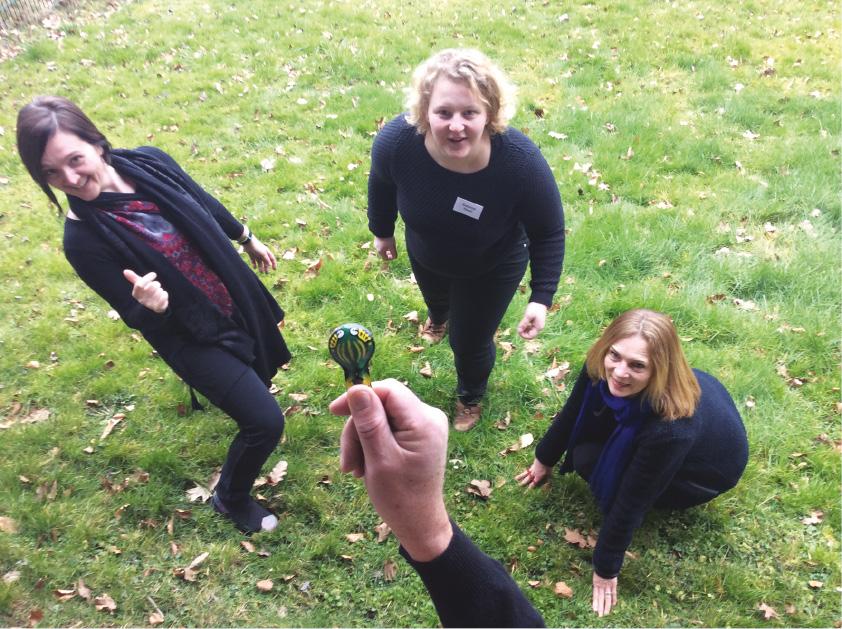
The object (a vintage metal sound-producing ‘toy’) as a hero in a fairy tale, overlooking its servants (source: author)
Each of these introductory sessions used ‘still images’, which can be related to common practices within theatre education (Neelands, 2010) wherein participants devise a situation and represent it as a static pose. However, such still theatrical images are frequently not meant to be recorded as actual images with a device, as this does not tend to be a goal in drama practice, especially in schools. In a similar manner, ‘freeze frames’ might be seen to borrow a concept from film: that of freezing the action as if the activity leader has pressed ‘pause’ on the group’s flowing motion. Both aspects were used to help teachers connect their notions of theatre to the boundaries and affordances of photography. The need to frame action and movement assisted the creation of more accurate positioning within the frame, and allowed participants to focus on the perspective of a character’s pose in relation to an audience. The presence of a capturing device affected the performance and allowed the group to discuss the director’s point of view, especially through the iPad, which allows for a quick sharing of the captured images. Davis (2012: 509) confirms this: ‘the use of a recording technology … framed the performance in such a way that the participants achieved a heightened awareness … they seemed to connect with their characters in a concrete way for the first time’, and ‘they were able to get visual and in some cases verbal feedback from other participants as the images were shared around’. This consciouness that someone is watching is a further area in which film and theatre education interconnect, which might usefully be introduced earlier within theatre pedagogy than in final rehearsals and performances.
Soundscape: Introducing sound in storytelling
Within the training programme, I felt strongly that our next step should be to explore a crucial area of film that is often neglected in school drama productions: sound. Sound is often assigned to a fellow musician, or sometimes to a musical soundtrack that simply ‘covers’ the action.
Within the training sessions, we went on to explore narratives implied by sound, and how sound can carry its own sense of meaning. Sounds can be created and captured in a process similar to that which we use for visuals. Understandings of perspective, background and depth of field can equally be transferred from visual to aural experiences. Our aim was to help trainees consider the semantics of sound in relation to how a story progresses, and the manner in which sounds can imply images, anticipation and feelings (which may also be suitable on stage). Groups were encouraged to rehearse with various objects and self-made sounds, channelling inspiration from a one-minute video they were shown depicting the work of foley artists. As shown in Figure 7 and Figure 8, the mapping design (a self-made ‘music sheet’) can itself be seen as a multimodal text, including two modes of communication (text and drawing), while referring to a third (sound) and implying a fourth (visuals), and further experiences still beyond these.
The final form of the group’s work developed during the rehearsal and recording process, and here we can find a connection to Kress and Van Leeuwen’s (2001: 61) description of ‘media’ (as material resources) in the production process: ‘the body and mouth and the tools which may extend bodily communication’ and affect the creative result, as the process of ‘production does not only realise what we have called designs’. The process for this soundscape exercise developed in four stages, each of which served multiple functions and could be repeated several times.
First, the group brainstormed the sound profile of their chosen narrative and location: Who might be there and what happens? How does the scene develop through time? What is the main feeling of the audience who witnesses it? Second, participants went on to imagine the respective sounds, making itemised lists and organising a narrative. A self-made music sheet with written and/or drawn elements served to map the group’s thoughts, organising sounds in chronology on a timeline, as well as their respective volumes. Third, roles were shared within the team as in an orchestra, with the group assigning both a sound recordist and a conductor. Fourth, a recording of the group’s work was made as one continuous take, with the relative lack of editing serving to reinforce the understanding of sequence and rhythm in relation to the desired narrative effect.
During the Kassel workshop, the theme assigned was ‘the railway station’, chosen for its strong intercultural and cinephilic character. The production of two different ‘railway stations’ within two neighbouring rooms revealed the creativity and subjectivity of sound, and how this neglected dimension of media and drama has a strong cultural capacity. By recording and listening (connecting microphones directly to a sound speaker), the group were able to reflect immediately upon their results, while beginning to appreciate the possibilities, as well as the technical limits, not only of the microphone, but also of the materials that they used and their performance. As one participant commented, ‘the importance of soundtracks has to be considered, [I] never thought about it [before] – also the viewing habits of our audience, it was fun.’
Participants in Group 2 used a classroom; they gradually discovered that the rubbish bin and the sliding whiteboard were more useful as ‘instruments’ than they had previously thought, and they used all available objects to improvise their own railway station. As seen in Figures 7 and 8, participants in Group 1 made a detailed plan, and then rehearsed and developed that given narrative of their railway station, based more on speech and less on improvisation. (This group’s work can be heard at https://soundcloud.com/karpos-1/human-trainwav.)
This activity served to teach participants classical narrative rules of cause and effect, as well as affording a chance to explore suggestive background atmospheres and foreground events, as being common to both theatre and film. In each instance, however, the eventual sound design was the result of a collective process, and it could be modified in a short time and include as many ‘tracks’ and layers as the idea required. Finally, the activity served to demonstrate to participants that sounds can help realise not only aural, but also visual rhythms. Participants were thus able to gain an understanding that media content is structured both in sequential order (on a timeline) and in layers (by using more than one parallel track). The exercise also served to establish two more characteristics of sound: the specific duration of each sound and the need for recording quality.
Film as an experience
The next part of the workshop sought to use the small achievements of all the introductory units that participants had explored to begin experiencing film, and to understand how a series of images can conspire to construct a complicated meaning. Here, film excerpts served to answer one of the original seminar questions regarding the use of film as an inspiration for theatre productions. Issues shared between theatre and film were used (such as theme, storyline, characters, setting, movement, rhythm and acting), and the value of the close-up assumed its full potential through extracts employed to inspire the groups’ own mixed-media productions.
A short look at early works of cinema served to illustrate the interconnection between film and theatre for, at that time, static camera perspectives reproduced more or less theatrical vignettes of everyday life. We screened excerpts from Dziga Vertov’s Man With a Movie Camera (1929), a film that itself serves as a commentary upon cinema as a cultural experience, and which demonstrates a range of cinematic techniques that Vertov invented, deployed or developed early in the history of cinema, alongside a novel celebration of close-ups. Although the film starts with a reference to an audience entering a theatre auditorium, and a city waking up, a big step away from theatre is subsequently articulated through an elaborate montage which, without any intertitles, subtly conveys passage of time and brings the (film’s) audience to a wide variety of locations with different atmospheres. Following this, we screened the first scene of Godard’s À bout de souffle (Breathless, 1960), which served as a ‘bridge’ connecting content and form: the cultural experience of cinema had developed to shape not only its audience’s experience, but also the nature of drama itself. Jump cuts, hand-held camera and unexpected sounds are introduced, which bring the audience to a position of thinking and responding to the film, rather than being simply absorbed in the story through flawless and invisible editing. Together, the two films illustrated to participants how elliptical narrative may develop, and how movement and human presence can be portrayed in various ways.
Production of video and theatre performance
The final assignment within the workshops was to create a script for a short video and theatre performance (between 5 and 10 minutes long) using a characteristic from one of the selected clips as a dominant element. From the two extracts, two activities were chosen as overarching themes: ‘waking up’ and ‘the chase’. Both, it seemed, would be familiar to anybody, no matter their cultural background or age, and both involved a complete dramatic structure. Waking up begins in sleep and ends when we reconnect to our everyday reality, while a chase has a cause, a beginning and an end. A character (the thief) was introduced, and participants were asked to consider formal devices which had been discussed and tried out during the first two days: close-up and point of view (see Table 2). Finally, the sound exercises depicting the railway station that we had worked on earlier were used as a background.
The exercise specifications clearly asked for a combination of film and theatre, but left it up to each group to decide the proportion and style of each combination, while specifying that the story should have a beginning, a middle and an end.
The results of the exercise from the three groups each embraced the points of inspiration from different, compelling perspectives. It was very pleasing for me to see in particular how the theme of ‘the chase’ developed in different ways, as well as the creative use of close-ups.
In Group 1’s final project, the story depicted a daylight nightmare, in which a teacher’s oppressive mother leads him to a hysterical chase, ending in a classroom. There, he regains self control, but a comforting picture of her proves that he still carries with him her homemade food! In terms of the format, the group initially employed aspects of classic film-making during the chase sequence, which was filmed in exterior locations until their protagonist opens a big door. At this point, the pre-recorded on-screen figure became a real actor coming through the same door, in a live context, in the stage room. At this point, the audience thus realised that they were watching the piece as members of the theatrical classroom, with the other group members acting as students. In terms of sound, live sound was used in both cases, with careful mixing during the passage from screen to stage.
In Group 2’s final project, a figure wakes up and starts running as if chased in a series of undefined interior and exterior spaces. Finally, the audience realises that this was a dream, as the person (recognised only by the same initial close-up shots) wakes up again. In this group’s work, a short dance (taking place live, in a theatre context) introduces a pre-recorded short film depicting the piece’s dominant narrative. The live dancing then returns, following the end of this film. In terms of sound, rhythmic electronic music was used, which gradually became more dominant, to lead the editing.
In Group 3’s work, a stressed traveller is rushing to catch a train, but he does not succeed. He is captured in a circular process of constant preparation. The group first used a pre-recorded aspect of film to represent the traveller’s journey, before a door was used to bring him into the theatrical space, in a live context. A relatively empty space obtained a focal point when the rest of the group surrounded the puzzled protagonist, holding iPads displaying pre-recorded materials. The loops playing on the iPads were close-ups of the protagonist’s body parts during his everyday routine of waking up. In this manner, the piece became a live installation. Figure 9 shows the protagonist surrounded by his peers, where they combine theatre and video in a clear and complementary manner. The use of close-ups functions in a particularly effective way, leading the eyes of the audience exactly to the details that the group directed them towards. This group in particular achieved both a collaborative and personal media practice; they revised their work themselves, and made a visible effort to orchestrate their work so as to take into account theatrical issues of pose and frontal visibility, and also the size and clarity of their close-ups in relation to the storyline and actor’s condition. In terms of sound, the initial filmed part of the piece used one of the railway station soundscapes as a soundtrack, which the group then gradually performed live in front of the audience as part of the finale of the theatrical piece.
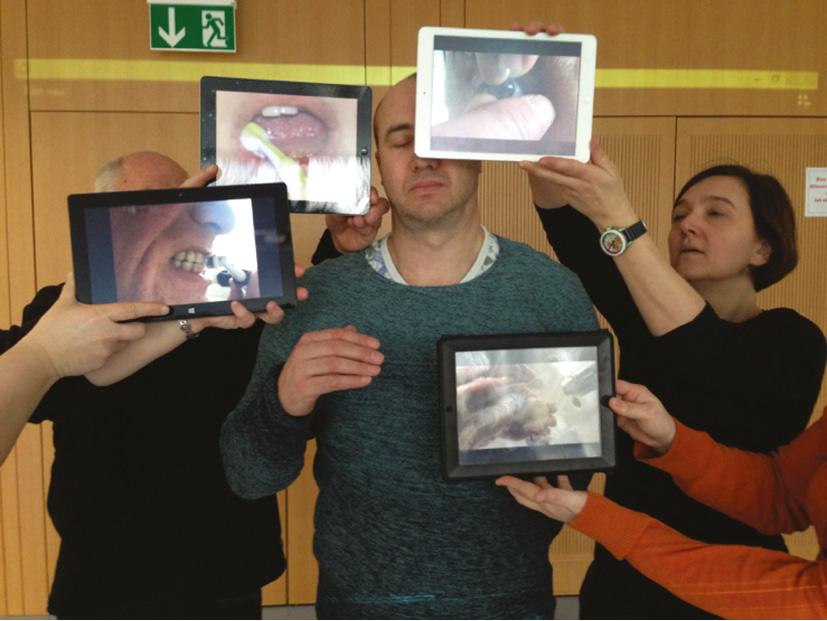
Pre-recorded close-ups take on a different meaning in relation to an acted pose (source: author)
Overall, the results of the exercise can be seen to demonstrate three distinctive uses of drama and video. The first two exercises were close to multidimensional theatrical experiences, which planned very precisely the exact moment of transition from one medium to the other. This might have been because they were using a more familiar mode (that of linear video), which was either connected to a ‘cut’ (as in in the work of Group 1) or a ‘dissolve’ (as in the work of Group 2, where the live dancing slowed down and the video faded in). It is worth mentioning that Group 2 almost forgot about the theatre element entirely, and brought it back to the performance at the very end. Here, one medium overshadowed the other, and film-making attained a central role. The group’s visually rich work with quick editing seemed to occupy most of their activity and attention. This group seemed initially to encounter a certain sense of a ‘dead end’ in their process, as they had a strong conception of atmosphere, but could not find a conclusion. Through discussion and experimentation, they were encouraged to reinforce their own idea of the abstract nightmarish chase, and to imply visually that the whole experience was a dream.
Group 3, however, sought a synchronous combination of the two mediums: following the conclusion of the pre-recorded film, the live protagonist had to act, and simultaneously the whole group ‘projected’ on to him images via their iPads. This required the planning and shooting of separate short videos while developing the scene. The secondary actors became ‘iPad stands’ (Figure 9). A demanding phase of the group’s rehearsals required these secondary actors to seamlessly hold their iPads, push the ‘play’ button at the right time, and subsequently be aware of the running time of each video in relation to the main actor’s movements. The collaboration and synchronicity of the group in relation to the overall aesthetic proved to be a major issue requiring an external directorial eye, which I had to provide myself. This group had the chance, however, to realise the connection of film to theatre in a more acute manner, as the two mediums were interwoven directly through performance – a characteristic that is common to both. The group had to consider the movement of bodies and the scenic direction of the whole performance, as well as the supposed point of view of the audience. Understanding of the essence and use of several close-ups, which in this case decorated and intensified what might be considered the wide shot (the actor himself), became apparent, and the group developed and improved their work through reshooting and refining angles.
Ultimately, all groups were able to combine aspects of film and theatre in their final performances, although arguably only one of the groups truly explored a liminal space between the two. Interestingly, this group had several members with a low level of confidence in technical equipment, as well as others with knowledge of video editing. One of the older participants, a recently retired theatre pedagogue, commented afterwards:
In theatre you often do not think of all the tiny details, but in film you have to, otherwise you cannot construct anything. The camera says what you have to see, while in theatre the whole thing goes on and on, and we have to manage how the audience sees that idea or reaction. It is easier in film with deconstruction and construction because you have to be so precise with what picture you take and show, and how you put the next picture after that, and you have to decide about the transitions.
Conclusions
Evaluation of the workshop took place in a circular reflection discussion at the end of the third day, from which two participants took written notes. As part of the evaluation, the group focused mainly upon the structure and content of the workshop and the learning which took place, and how this related to the aims of their teaching, especially regarding drama and film. Enthusiastic about participatory processes, the whole group, including myself as their trainer, had to approach collective creativity, memory, body language and the continuous development of new concepts, within a bilingual setting where English as a working language was not the first language of any participant.
Taking into account the rich experience of these theatre teachers, the seminar became a space of high-level collaboration: bodily participation, performance and improvisation were part of the everyday language of these teachers, and thus we could easily incorporate these aspects, and then focus upon creative and aesthetic accuracy. Media skills and understanding were, however, very varied, and this created space for testing the engagement and effectiveness of the activities.
In several cases during the introductory exercises, a member of the group proposed an alteration or a new version. This revealed the specificities of media and theatre, and the extent to which an expressive and learning process may be altered and for what reason. For example, in the case of one of the sound-based introductory activities, one of the proposed variations within the exercise specification caused the activity to lose focus. The proposal introduced too many theatrical elements at the same time, including aspects of dialogue and the move into a new space while holding the microphone. Figure 10 shows the tendency of the sound recordist to be more directly engaged with actors and dialogue than with other aspects of what actually is recorded, neglecting perspective, atmosphere and ambiguity. Questions of distance, the control of space and the position of actors affected crucially the result of the soundscapes due to microphone capabilities and restrictions. This exercise in particular aimed to reveal depth of field and recording pickup patterns in sound, so the temporal and spatial imperatives of drama effectively cancelled the point of view of a sound-recording medium, an aspect of practice that requires further research.
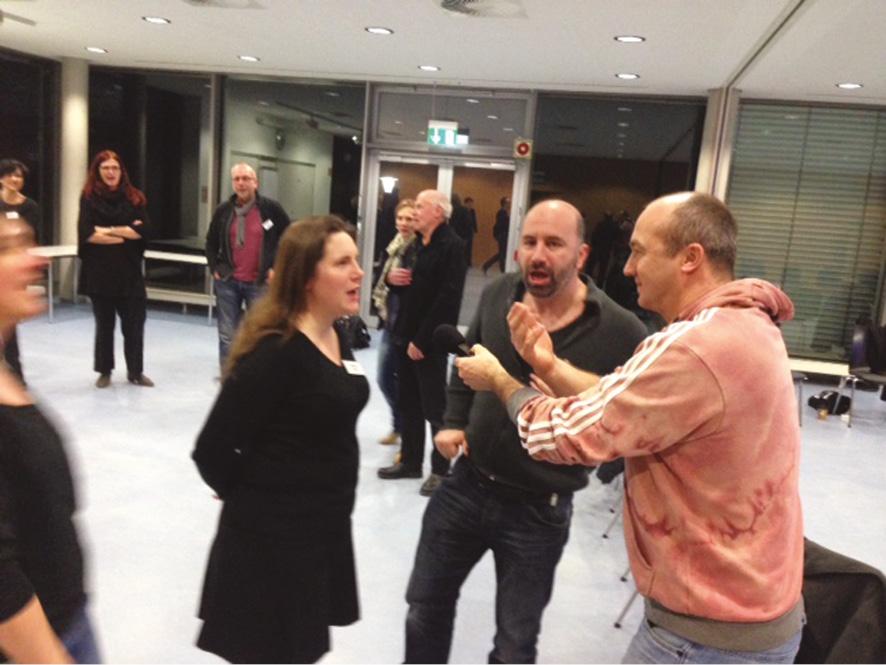
Excessive aspects of theatricality may cause sound tutorials to lose focus (source: author)
As the seminar was focused on adult training, peers were able to challenge each other in order to foster collaboration and development (Kuusisaari, 2014). Small achievements from the first two days were used to build their final projects in a variety of manners in a very short time. As one of the participants described: ‘getting to know different building blocks is good, the small appetisers made this clear. I take many small ideas with me. Very well structured, started with little exercises which came to large contexts.’
Aspects of cinema were transferred to live, scenic representation in multiple ways, which the participants seemed to feel confident they could subsequently transfer to their own work with students. Participant feedback confirmed my own conviction that teaching and learning can themselves be storytelling experiences. As another of the participants remarked: ‘I was inspired by the way, in this workshop, each step created space for the next, and each further part was based on ideas that we had developed before.’ Other participants made the following comments:
Film is always very time consuming and needs small clear tasks; you need a clear plan for a movie, otherwise you get bogged down and waste a lot of time; in this workshop I found little ideas to work without big complicated video and still use the idea of film. (Participant A)
It helped by setting the frame, and giving the three themes (for the final project), and this should be the same with our students, the clearer the setting the easier it is going to work. (Participant B)
I am willing to improve my abilities now, I am ambitious, it was like a teaser, I got on trying and now I want to learn more. Many students have good technical knowledge that I can use. (Participant C)
These comments seem to focus in particular on two aspects of learning. First, on the methodology of building blocks or small ideas, by which introductory exercises focused upon tangible, creative aspects progressed to a wider concept. This would seem a necessary process through which to foster understandings of multifaceted moving image elements, and to connect these to theatre. Second, the notion of ‘setting the frame’ seems a highly useful concept in working productively with students. Especially regarding teaching film and theatre together, I observed that participants in the workshops made new connections between the two modes (‘soundtrack’, ‘the viewing habits of the audience’), while also gaining aspects of confidence that made film more accessible.
Ultimately, my experience leading this workshop seems to illustrate that these small steps connecting the two arts allow the familiarity that one gains with one mode to facilitate the knowledge of, and expression through, the other. This could be considered a multimodal approach to film-making – that is, an approach that acknowledges the meaning-making qualities of body, gestures, voices and so on. On the other hand, a filmic approach to theatre might mean the presence of, and attention to, framing and juxtaposition in precise uses of two dimensions.
It would thus seem that, while each medium has certain distinctive qualities, they also have in common the possibility to work with stories that can transcend from one form to another. Such an approach consequently allows us to connect aspects of curricular content and outcomes with hands-on practice and theory through short moments of story and expression. In search of starting points for such an approach to teaching and learning, we might search for locations, or indeed elements of atmosphere or action, which can serve as points of departure for students. Each choice will lead learners on to a set of possible scripts, and to better understandings of concepts and nuances, and the variables of actions and situations.
Ultimately, this article advocates an approach that I argue may help teachers master basic principles and build confidence with the language of images and sounds, which continues to be an important factor in offline and online communication today, and – in particular – in the media habits of young people. Film and theatre share a certain persistence in the ‘frame’ – whether that be rectangular and materially specific, or as wide as a proscenium arch, and this remains a key aspect of their mutual approaches to storytelling.


